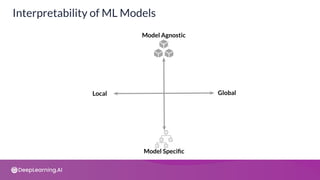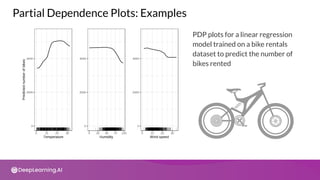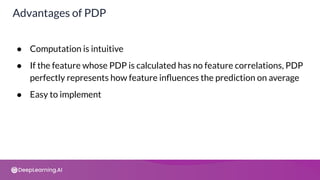C3 w5
- 1. Copyright Notice These slides are distributed under the Creative Commons License. DeepLearning.AI makes these slides available for educational purposes. You may not use or distribute these slides for commercial purposes. You may make copies of these slides and use or distribute them for educational purposes as long as you cite DeepLearning.AI as the source of the slides. For the rest of the details of the license, see https://creativecommons.org/licenses/by-sa/2.0/legalcode
- 4. ● Development of AI is creating new opportunities to improve lives of people ● Also raises new questions about the best way to build the following into AI systems: ● Ensure working towards systems that are fair and inclusive to all users. ● Explainability helps ensure fairness. Fairness Responsible AI Training models using sensitive data needs privacy preserving safeguards. Privacy Identifying potential threats can help keep AI systems safe and secure. Security ● Understanding how and why ML models make certain predictions. ● Explainability helps ensure fairness. Explainability
- 5. The field of XAI allow ML system to be more transparent, providing explanations of their decisions in some level of detail. These explanations are important: To ensure algorithmic fairness. Identify potential bias and problems in training data. To ensure algorithms/models work as expected. Explainable Artificial Intelligence (XAI)
- 6. Need for Explainability in AI 2. Attacks 3. Fairness 4. Reputation and Branding 6. Customers and other stakeholders may question or challenge model decisions 5. Legal and regulatory concerns 1. Models with high sensitivity, including natural language networks, can generate wildly wrong results
- 7. DNNs can be fooled into misclassifying inputs with no resemblance to the true category. Deep Neural Networks (DNNs) can be fooled
- 8. +ε “Panda” 57.7 % confidence “Gibbon” 99.3 % confidence “Nematode” 8.2 % confidence Deep Neural Networks (DNNs) can be fooled
- 10. “(Models) are interpretable if their operations can be understood by a human, either through introspection or through a produced explanation.” “Explanation and justification in machine learning: A survey” - O. Biran, C. Cotton What is interpretability?
- 11. You should be able to query the model to understand: Why did the model behave in a certain way? How can we trust the predictions made by the model? What information can model provide to avoid prediction errors? What are the requirements?
- 12. Interpretation Methods Model Specific or Model Agnostic? Local or Global? Intrinsic or Post-Hoc? Categorizing Model Interpretation Methods
- 13. Intrinsic Interpretability Model which is intrinsically interpretable Linear models, Tree-base d models, Lattice, etc Intrinsic or Post-Hoc?
- 14. Intrinsic or Post-Hoc? ● Post-hoc methods treat models as black boxes ● Agnostic to model architecture ● Extracts relationships between features and model predictions, agnostic of model architecture ● Applied after training
- 15. Feature Summary Visualization Feature Summary Statistics Model Internals Data point Types of results produced by Interpretation Methods
- 16. ● These tools are limited to specific model classes ● Example: Interpretation of regression weights in linear models ● Intrinsically interpretable model techniques are model specific ● Tools designed for particular model architectures Model Specific Data Model Prediction Explanation ● Applied to any model after it is trained ● Do not have access to the internals of the model ● Work by analyzing feature input and output pairs Model Agnostic Data Prediction Explanation model magic Model Specific or Model Agnostic
- 17. Model Agnostic Model Specific Local Global Interpretability of ML Models
- 18. Local or Global? ● Local: interpretation method explains an individual prediction. ● Feature attribution is identification of relevant features as an explanation for a model.
- 19. Local or Global? ● Global: interpretation method explains entire model behaviour ● Feature attribution summary for the entire test data set
- 21. Intrinsically Interpretable Models ● How the model works is self evident ● Many classic models are highly interpretable ● Neural networks look like “black boxes” ● Newer architectures focus on designing for interpretability
- 22. Monotonic Monotonic Not Monotonic Monotonicity improves interpretability
- 23. Algorithm Linear Monotonic Feature Interaction Task Linear regression Yes Yes No regr Logistic regression No Yes No class Decision trees No Some Yes class, regr RuleFit Yes* No Yes class, regr K-nearest neighbors No No No class, regr TF Lattice Yes* Yes Yes class, regr Interpretable Models
- 24. Neural Networks SVMs Random Forests K-nearest neighbours Decision Trees Linear Regression Accuracy Interpretability Interpretability vs Accuracy Trade off TF Lattice Model Architecture Influence on Interpretability
- 26. Linear models have easy to understand interpretation from weights Interpretation from Weights ● Numerical features: Increase of one unit in a feature increases prediction by the value of corresponding weight. ● Binary features: Changing between 0 or 1 category changes the prediction by value of the feature’s weight. ● Categorical features: one hot encoding affects only one weight.
- 27. Feature Importance ● Relevance of a given feature to generate model results ● Calculation is model dependent ● Example: linear regression model, t-statistic
- 28. More advanced models: TensorFlow Lattice ● Overlaps a grid onto the feature space and learns values for the output at the vertices of the grid ● Linearly interpolates from the lattice values surrounding a point
- 29. More advanced models: TensorFlow Lattice ● Enables you to inject domain knowledge into the learning process through common-sense or policy-driven shape constraints ● Set constraints such as monotonicity, convexity, and how features interact
- 30. TensorFlow Lattice: Accuracy Accuracy ● TensorFlow Lattice achieves accuracies comparable to neural networks ● TensorFlow Lattice provides greater interpretability
- 31. TensorFlow Lattice: Issues Dimensionality ● The number of parameters of a lattice layer increases exponentially with the number of input features ● Very Rough Rule: Less than 20 features ok without ensembling
- 32. Understanding Model Predictions Model Agnostic Methods
- 33. These methods separate explanations from the machine learning model. Model Agnostic Methods Desired characteristics: ● Model flexibility ● Explanation flexibility ● Representation flexibility
- 34. Partial Dependence Plots Individual Conditional Expectation Accumulated Local Effects Permutation Feature Importance Permutation Feature Importance Global Surrogate Local Surrogate (LIME) Shapley Values SHAP Model Agnostic Methods
- 35. Partial Dependence Plots Understanding Model Predictions
- 36. Partial Dependence Plots (PDP) A partial dependence plot shows: ● The marginal effect one or two features have on the model result ● Whether the relationship between the targets and the feature is linear, monotonic, or more complex
- 37. The partial function fxs is estimated by calculating averages in the training data: Partial Dependence Plots
- 38. PDP plots for a linear regression model trained on a bike rentals dataset to predict the number of bikes rented Partial Dependence Plots: Examples
- 39. 4000 Spring Summer Fall Winter Season 0 2000 PDP for Categorical Features
- 40. ● Computation is intuitive ● If the feature whose PDP is calculated has no feature correlations, PDP perfectly represents how feature influences the prediction on average ● Easy to implement Advantages of PDP
- 41. Disadvantages of PDP ● Realistic maximum number of features in PDP is 2 ● PDP assumes that feature values have no interactions
- 43. Permutation Feature Importance Feature importance measures the increase in prediction error after permuting the features Feature is important if: ● Shuffling its values increases model error Feature is unimportant if: ● Shuffling its values leaves model error unchanged
- 44. ● Estimate the original model error ● For each feature: ○ Permute the feature values in the data to break its association with the true outcome ○ Estimate error based on the predictions of the permuted data ○ Calculate permutation feature importance ○ Sort features by descending feature importance . Permutation Feature Importance
- 45. pretation: Shows the increase in model error feature's information is destroyed. Advantages of Permutation Feature Importance ● Nice interpretation: Shows the increase in model error when the feature's information is destroyed. ● Provides global insight to model’s behaviour ● Does not require retraining of model
- 46. Disadvantages of Permutation Feature Importance ● It is unclear if testing or training data should be used for visualization ● Can be biased since it can create unlikely feature combinations in case of strongly correlated features ● You need access to the labeled data
- 48. ● The Shapley value is a method for assigning payouts to players depending on their contribution to the total ● Applying that to ML we define that: ○ Feature is a “player” in a game ○ Prediction is the “payout” ○ Shapley value tells us how the “payout” (feature contribution) can be distributed among features Shapley Value
- 49. 50m2 2nd floor €300,000 Suppose you trained an ML model to predict apartment prices You need to explain why the model predicts €300,000 for a certain apartment. Average prediction of all apartments: €310,000. Shapley Value: Example
- 50. Term in Game Theory Relation to ML Relation to House Prices Example Game Prediction task for single instance of dataset Prediction of house prices for a single instance Gain Actual prediction for instance - Average prediction for all instances Prediction for house price (€300,000) - Average Prediction(€310,000) = -€10,000 Players Feature values that contribute to prediction ‘Park=nearby’, ‘cat=banned’, ‘area=50m2 ’, ‘floor=2nd’ Shapley Value
- 51. Feature Contribution ‘park-nearby’ €30,000 size-50 €10,000 floor-2nd €0 cat-banned -€50,000 Total: -€10,000 (Final prediction - Average Prediction) One possible explanation Shapley Value Goal : Explain the difference between the actual prediction (€300,000) and the average prediction (€310,000): a difference of -€10,000.
- 52. Based on solid theoretical foundation. Satisfies Efficiency, Symmetry, Dummy, and Additivity properties Enables contrastive explanations Value is fairly distributed among all features Advantages of Shapley Values
- 53. ● Computationally expensive ● Can be easily misinterpreted ● Always uses all the features, so not good for explanations of only a few features. ● No prediction model. Can’t be used for “what if” hypothesis testing. ● Does not work well when features are correlated Disadvantages of Shapley Values
- 54. SHAP (SHapley Additive exPlanations) Understanding Model Predictions
- 55. ● SHAP (SHapley Additive exPlanations) is a framework for Shapley Values which assigns each feature an importance value for a particular prediction SHAP ● Includes extensions for: ○ TreeExplainer: high-speed exact algorithm for tree ensembles ○ DeepExplainer: high-speed approximation algorithm for SHAP values in deep learning models ○ GradientExplainer: combines ideas from Integrated Gradients, SHAP, and SmoothGrad into a single expected value equation ○ KernelExplainer: uses a specially-weighted local linear regression to estimate SHAP values for any model
- 56. SHAP Explanation Force Plots ● Shapley Values can be visualized as forces ● Prediction starts from the baseline (Average of all predictions) ● Each feature value is a force that increases (red) or decreases (blue) the prediction
- 58. SHAP Dependence Plot with Interaction
- 59. Testing Concept Activation Vectors Understanding Model Predictions
- 60. Testing Concept Activation Vectors (TCAV) Concept Activation Vectors (CAVs) ● A neural network’s internal state in terms of human-friendly concepts ● Defined using examples which show the concept
- 61. Example Concepts
- 63. Local Interpretable Model-agnostic Explanations (LIME) ● Implements local surrogate models - interpretable models that are used to explain individual predictions ● Using data points close to the individual prediction, LIME trains an interpretable model to approximate the predictions of the real model ● The new interpretable model is then used to interpret the real result
- 65. Explain why an individual data point received that prediction Debug odd behavior from a model Refine a model or data collection process Verify that the model’s behavior is acceptable Present the gist of the model Google Cloud AI Explanations for AI Platform
- 66. AI Explanations: Feature Attributions Tabular Data Example
- 67. AI Explanations: Feature Attributions Image Data Examples
- 68. AI Explanations: Feature Attribution Methods
- 69. AI Explanations: Integrated Gradients A gradients-based method to efficiently compute feature attributions with the same axiomatic properties as Shapley values
- 70. AI Explanations: XRAI (eXplanation with Ranked Area Integrals) XRAI assesses overlapping regions of the image to create a saliency map ● Highlights relevant regions of the image rather than pixels ● Aggregates the pixel-level attribution within each segment and ranks the segments
- 71. AI Explanations: XRAI (eXplanation with Ranked Area Integrals)






































































